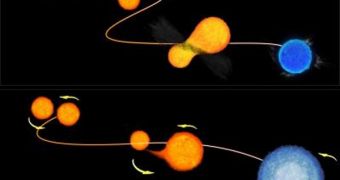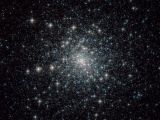One of the most enduring mysteries in astrophysics was until recently the mechanism that some stars in globular clusters used to appear younger than they actually were. As a general rule, the celestial bodies in these structures are very old, with an age estimated to be around 12 and 13 billion years. But, while most of their stars look their age, some appear to be a lot younger. In addition, they also appear to be younger as the time passes, reverting to a more active, brighter stage. Until recently, astrophysicists had no idea as to why this was happening.
A new investigation, led by expert Francesco Ferraro, of the University of Bologna in Italy, now proposes a new explanation for the phenomenon. The work was conducted on the Messier 30 stellar cluster, a formation that appeared more than 13 billion years ago. Discovered by the famous astronomer Charles Messier in 1764, the space structure lies some 28,000 light-years away from our planet, and contains several hundreds of thousands of stars. Its diameter spans some 90 light-years across.
The astronomers aimed at analyzing the blue stragglers inside Messier 30. These are the stars that appear to be getting younger, brighter and hotter as the time passes. “It's like seeing a few kids in the group picture of a rest-home for retired people. It is natural to wonder why they are there,” Ferraro says. The existence of this type of stars was discovered in the 1950s, but their origins remained unexplained until now. There are two main theories to explain the existence of blue stragglers, the team says. One revolves around vampirism, while the second around galactic collisions.
In the former, the stragglers arise in small, binary systems, in which the smaller star starts siphoning material from the larger one, restocking its own fuel and getting warmer and brighter. To external observers, such as we are, these stars appear to be getting bluer, therefore younger than they actually are. The second theory, which was now proposed by the team, says that some of the blue stragglers were formed through galactic collisions, when two other stars collided head-on with each other. This event would have led to their materials mixing, restocking the nuclear fusion process that fired up stars.
“Our observations demonstrate that blue stragglers formed by collisions have slightly different properties from those formed by vampirism. This provides a direct demonstration that the two formation scenarios are valid and that they are both operating simultaneously in this cluster,” one of the team members, Giacomo Beccari, explains. He is based at the European Space Agency (ESA).
“The two distinct populations of blue stragglers discovered in Messier 30 are the relics of the collapse of the core that occurred two billion years ago. In a broad context our discovery is direct evidence of the impact of star cluster dynamics on stellar evolution. We should now try to see if other globular clusters present this double population of blue stragglers,” Ferraro concludes.

 14 DAY TRIAL //
14 DAY TRIAL // 
